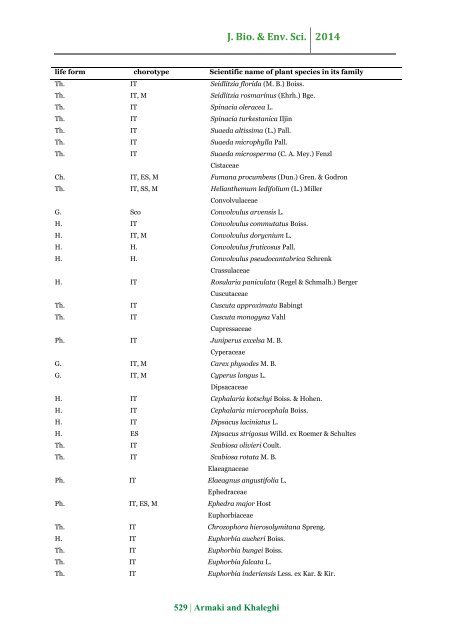Presentation of flora, life forms and chorology of rural range plants in the North East Azarbaijan province, Iran
Abstract Floristic studies are fundamental for the applied sciences such as rangeland management and conservation. Unique ecological and climatic conditions in the North East Azarbaijan Province (NAP) make it a remarkable habitat for the floristic studies. Plant species were collected from 50 field sites, representing major habitats of winter and rural rangelands. Surveys were conducted during active growth periods in 2012 and 2013. Plant species were identified and their chorology and life form determined through laboratory examinations and by using reference books. Floristic surveys resulted in identification of 534 plant species, belonged to 315 genus and 68 families. Asteraceae, Poaceae and Fabaceae were respectively the most abundant plant families. Among the life forms, Hemicryptophytes, Therophytes, Chamaephytes, Phanerophytes and Geophytes included 45, 32, 9, 7 and 7% of the total species, respectively. Irano-Turanian was the most dominant (65%) Chorotypes. The dominance of Hemicryptophytes and Therophytes, as well as vast distribution of Chamaephytes, can be referred to the simultaneous effects of climate fluctuations and livestock grazing on the flora of winter and rural rangelands in NAP.
Abstract
Floristic studies are fundamental for the applied sciences such as rangeland management and conservation. Unique ecological and climatic conditions in the North East Azarbaijan Province (NAP) make it a remarkable habitat for the floristic studies. Plant species were collected from 50 field sites, representing major habitats of winter and rural rangelands. Surveys were conducted during active growth periods in 2012 and 2013. Plant species were identified and their chorology and life form determined through laboratory examinations and by using reference books. Floristic surveys resulted in identification of 534 plant species, belonged to 315 genus and 68 families. Asteraceae, Poaceae and Fabaceae were respectively the most abundant plant families. Among the life forms, Hemicryptophytes, Therophytes, Chamaephytes, Phanerophytes and Geophytes included 45, 32, 9, 7 and 7% of the total species, respectively. Irano-Turanian was the most dominant (65%) Chorotypes. The dominance of Hemicryptophytes and Therophytes, as well as vast distribution of Chamaephytes, can be referred to the simultaneous effects of climate fluctuations and livestock grazing on the flora of winter and rural rangelands in NAP.
Create successful ePaper yourself
Turn your PDF publications into a flip-book with our unique Google optimized e-Paper software.
J. Bio. & Env. Sci. 2014<br />
<strong>life</strong> form chorotype Scientific name <strong>of</strong> plant species <strong>in</strong> its family<br />
Th. IT Seidlitzia florida (M. B.) Boiss.<br />
Th. IT, M Seidlitzia rosmar<strong>in</strong>us (Ehrh.) Bge.<br />
Th. IT Sp<strong>in</strong>acia oleracea L.<br />
Th. IT Sp<strong>in</strong>acia turkestanica Ilj<strong>in</strong><br />
Th. IT Suaeda altissima (L.) Pall.<br />
Th. IT Suaeda microphylla Pall.<br />
Th. IT Suaeda microsperma (C. A. Mey.) Fenzl<br />
Cistaceae<br />
Ch. IT, ES, M Fumana procumbens (Dun.) Gren. & Godron<br />
Th. IT, SS, M Helian<strong>the</strong>mum ledifolium (L.) Miller<br />
Convolvulaceae<br />
G. Sco Convolvulus arvensis L.<br />
H. IT Convolvulus commutatus Boiss.<br />
H. IT, M Convolvulus dorycnium L.<br />
H. H. Convolvulus fruticosus Pall.<br />
H. H. Convolvulus pseudocantabrica Schrenk<br />
Crassulaceae<br />
H. IT Rosularia paniculata (Regel & Schmalh.) Berger<br />
Cuscutaceae<br />
Th. IT Cuscuta approximata Bab<strong>in</strong>gt<br />
Th. IT Cuscuta monogyna Vahl<br />
Cupressaceae<br />
Ph. IT Juniperus excelsa M. B.<br />
Cyperaceae<br />
G. IT, M Carex physodes M. B.<br />
G. IT, M Cyperus longus L.<br />
Dipsacaceae<br />
H. IT Cephalaria kotschyi Boiss. & Hohen.<br />
H. IT Cephalaria microcephala Boiss.<br />
H. IT Dipsacus lac<strong>in</strong>iatus L.<br />
H. ES Dipsacus strigosus Willd. ex Roemer & Schultes<br />
Th. IT Scabiosa olivieri Coult.<br />
Th. IT Scabiosa rotata M. B.<br />
Elaeagnaceae<br />
Ph. IT Elaeagnus angustifolia L.<br />
Ephedraceae<br />
Ph. IT, ES, M Ephedra major Host<br />
Euphorbiaceae<br />
Th. IT Chrozophora hierosolymitana Spreng.<br />
H. IT Euphorbia aucheri Boiss.<br />
Th. IT Euphorbia bungei Boiss.<br />
Th. IT Euphorbia falcata L.<br />
Th. IT Euphorbia <strong>in</strong>deriensis Less. ex Kar. & Kir.<br />
529 | Armaki <strong>and</strong> Khaleghi





![Review on: impact of seed rates and method of sowing on yield and yield related traits of Teff [Eragrostis teff (Zucc.) Trotter] | IJAAR @yumpu](https://documents.yumpu.com/000/066/025/853/c0a2f1eefa2ed71422e741fbc2b37a5fd6200cb1/6b7767675149533469736965546e4c6a4e57325054773d3d/4f6e6531383245617a537a49397878747846574858513d3d.jpg?AWSAccessKeyId=AKIAICNEWSPSEKTJ5M3Q&Expires=1716386400&Signature=%2BwTz3G%2BoJrJhfALTk2ZuHTQvmo4%3D)












